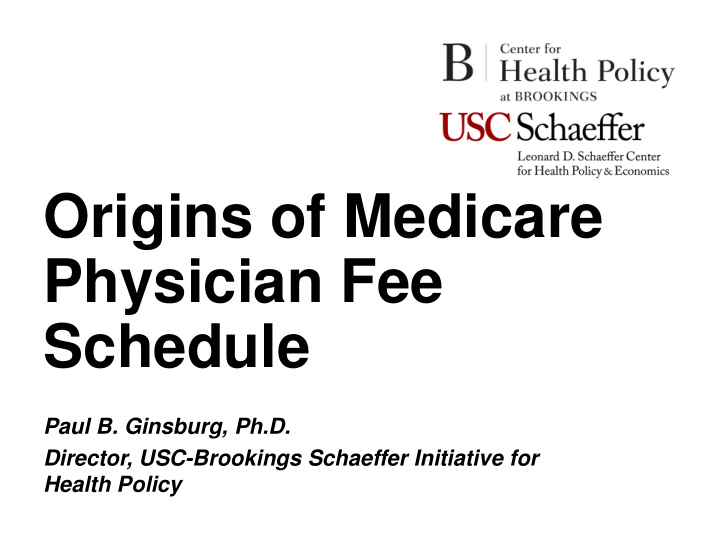



Origins of Medicare Physician Fee Schedule Paul B. Ginsburg, Ph.D. Director, USC-Brookings Schaeffer Initiative for Health Policy
Context for Reform • Initiative came from the Congress – Engaged Administration in the process • Concerns about imbalance in fee structure – Procedures versus visits – Urban versus rural (especially in Senate) – Environment of deficit reduction – Administration concerns about excessive volume 2
Process Leading to Reform • Directive to fund a relative value study • Creation of PPRC – Very specific mandate • Key preliminary legislation 3
Major Design Issues (1) • Science-based approach to set relative values – Measurement of physician work, practice expenses Intensity component of work – Simulation of hypothetical market Instead of cues from dysfunctional market – Absence of attempt to specify absolute or relative physician incomes 4
Major Design Issues (2) • Attempts to address volume – Volume Performance Standards (VPS) Engage leadership of medical profession Recognition of tragedy of commons SGR pushed idea too hard • Stringent limits on balance billing – Longstanding priority of AARP – Reinforced revised structure of fees 5
Major Design Issues (3) • Updating physician work values – AMA and the RUC Specialty societies working within AMA rather than lobbying CMS or Congress 6
Early Experience with Reform (1) • Substantial shift in resources toward payment for visits – Surprise to younger observers – Shift likely undone by inadequate updating process • VPS did not blow up • Medicaid programs and private insurers adopted the Medicare RVS 7
Early Experience with Reform (2) • Little Congressional micromanagement – But significant concerns about current payment distortions Some steps to reduce extreme overpayments (advanced imaging) Directives to CMS to more vigorously address current distortions 8
Physician Fee Schedule: The History and Role of the RUC Barbara Levy, MD, FACOG, FACS Vice President, Health Policy The American College of Obstetricians and Gynecologists RUC Chair 2009-2015
CODING: The Foundation for Payment CPT – Current Procedural Terminology – Over 7000 codes to define “what was done” ICD-10 - International Classification of Diseases – Version 10 Over 68,000 codes to define “why”
Current Payment System AMA convened an expert panel – the RUC (RBRVS Update Committee) to recommend work and practice expense RVUs to HCFA (now CMS)
The RUC Process: Physician Work RUC has been developing recommendations since 1992; utilizing same methodology as Hsaio/Harvard Data collected by national medical specialty societies Time it takes to perform procedure Intensity of service as compared to other physician services
The RUC Process RUC Advisory Committee – One physician representative and one staff appointment from more than 100 specialty societies Health Care Professionals Advisory Committee – Allows for participation by non-MD/DO health professionals who are required to use CPT and RBRVS
Current System Payment is for “piece work” All MDs paid the same for any procedure regardless of specialty designation, experience or outcomes Both physicians and hospitals have driven volume to increase reimbursement Industry has contributed to the escalation in healthcare costs
RUC Improvements: COMPOSITION: Additional permanent seats for Geriatrics and Primary Care TRANSPARENCY: All meetings are open with votes and minutes posted publicly
Improving the Valuation Within RBRVS Developed objective screens to sort through the >7000 CPT codes Over 1,700 potentially misvalued services from these objective screens identified Completed review of over 1,300 services RUC’s review of potentially misvalued codes accounts for approximately $38 billion in Medicare allowed charges
Unintended consequences of RBRVS Office vs. Hospital payments CPT Code Office-based physician Hospital Payment* payment 99201 $41.11 $78.18 99202 $71.01 $124.06 99203 $102.95 $174.46 99204 $158.33 $254.87 99205 $197.06 $331.33 99211 $19.71 $61.53 99212 $41.45 $100.27 99213 $68.97 $124.40 99214 $102.27 $175.48 99215 $137.60 $235.51 Source: Centers for Medicare and Medicare Services 2011 * Hospital payments include monies to physician and monies to hospital
Change must be embraced….. the cost of providing healthcare in the United States is simply too high
The Environment - Investment in Health Care
Potential Roles for RUC & CPT Panel in Alternative Payment Models Setting relative values of bundled and condition-based payments Defining new codes for bundled and condition-based payments Current RBRVS values may or may not reflect appropriate allocations of effort or practice expenses within team-based models
Potential Roles for RUC & CPT Panel in Alternative Payment Models Adjusting relative values over time Flexible payments will encourage innovations in care delivery that reduce costs New technologies and evidence about outcomes may require higher payments
Is there a future for the RUC? …If we want to have a venue to discuss, assess and critique payment systems …If we want physicians to have a voice in determining the distribution of resources among providers …If we want to groom physician leaders in health policy who will drive quality, reduce costs and reaffirm professionalism in American medicine (Berenson )
Thank You! Barbara Levy, MD, FACOG, FACS blevy@acog.org
Recommend
More recommend